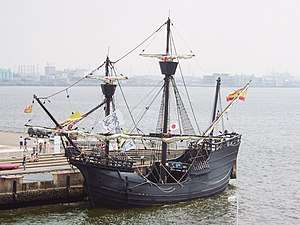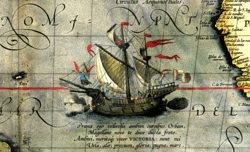Victoria (ship)
Victoria (or Nao Victoria) was a carrack and the first ship to successfully circumnavigate the world. Victoria was part of a Spanish expedition commanded by the Portuguese explorer Ferdinand Magellan, and after his death during the voyage, by Juan Sebastián Elcano. The expedition began on 10 August 1519 with five ships. However, Victoria was the only ship to complete the voyage, returning on 6 September 1522.[2] Magellan was killed in the Philippines.
 | |
| History | |
|---|---|
| Crown of Spain | |
| Name: | Victoria |
| Namesake: | Santa Maria de la Victoria |
| Owner: | Ferdinand Magellan/Sebastian Elcano |
| Ordered: | 1518 |
| Launched: | 1519 |
| Fate: | Disappeared en route to Seville from the Antilles, 1570 [1] |
| Notes: | First ship to circumnavigate the globe. |
| General characteristics | |
| Class and type: | Carrack |
| Tonnage: | 85 |
| Length: | 18 to 21 metres (59 to 69 ft) |
| Complement: | 55 |
The ship was built at a shipyard in Ondarroa, with the Basques being reputed shipbuilders at the time, and along with the four other ships, she was given to Magellan by King Charles I of Spain (The Holy Roman Emperor Charles V). Victoria was named after the church of Santa Maria de la Victoria de Triana, where Magellan took an oath of allegiance to Charles V.[2] Victoria was an 85-ton ship with a crew of 42.
The four other ships were Trinidad (110 tons, crew 55), San Antonio (120 tons, crew 60), Concepcion (90 tons, crew 45), and Santiago (75 tons, crew 32). Trinidad, Magellan's flagship, Concepcion, and Santiago were wrecked or scuttled; San Antonio deserted the expedition during the navigation of the Straits of Magellan and returned to Europe on her own.
Victoria was a carrack or nao, as were all the others except Santiago, which was a caravel.[3]
Construction

While agreeing on its Basque origin, for a long period the vessel was thought to have been constructed in Zarautz, next to Elcano's home town Getaria. However, research conducted by local historians has revealed that the nao Victoria was built at the shipyards of Ondarroa in Biscay. It was originally called Santa Maria, owned by Domingo Apallua, a ship pilot, and his son, Pedro Arismendi.[4]
According to a notarial document dating from 1518, the ship had been used in previous years for trade between Castile and England. Royal Castilian officials bought the ship at a set price of 800 gold ducats, a figure at odds with the estimation on the ship's real value provided by the accountant of Magellan's expedition, and accepted by the owners only against their will.[4] The ship was named Victoria by Magellan after the chapel he frequented on his prayers in Seville, the Santa María de la Victoria.[4]
Crew
The voyage started with a crew of about 265 men aboard five ships, however only 18 men returned alive on Victoria, while many others had deserted. Many of the men died of malnutrition. At the beginning of the voyage, Luis de Mendoza was her captain. On 2 April 1520, after establishing a settlement in Puerto San Julian in Patagonia, a fierce mutiny involving three captains broke out but was ultimately quelled.[5] Antonio Pigafetta's and other reports state that Luis de Mendoza and Gaspar Quesada, captain of Concepcion, were executed and their remains hung on gallows on the shore.[5][6]
Juan de Cartagena, captain of San Antonio, was marooned on the coast. According to Pigafetta, after Magellan's death on 27 April 1521, at the Battle of Mactan, remnants of the fleet tried to retrieve his body without success. Thereafter, Duarte Barbosa, a Portuguese who had sided with Magellan in facing the mutiny, and João Serrão were elected leaders of the expedition. On 1 May 1521, they were invited by rajah Humabon of Cebu to a banquet ashore to receive a gift for the king of Spain. At the banquet, most of the crew were killed or poisoned, including Duarte Barbosa and João Serrão, who the natives wanted to exchange for Western weapons, but was left behind by the remaining crew. Pilot João Carvalho, who had survived the trap, then became the captain of Victoria. In August, near Borneo he was deposed and Juan Sebastián Elcano became captain for the remainder of the expedition.
Returning crew
Out of an entire expedition of 260 people, only 18 returned to Seville with the expedition (many others deserted), which by the end was only made up of the crew of Victoria.
They were:
| Name | Rating | Nationality | Hometown |
|---|---|---|---|
| Juan Sebastián Elcano | Master | Basque | Getaria |
| Francisco Albo | Pilot | Greek | Chios |
| Miguel de Rodas | Pilot | Galician | Tui |
| Juan de Acurio | Pilot | Basque | Bermeo |
| Antonio Lombardo (Pigafetta) | Supernumerary | Venetian | Vicenza |
| Martín de Judicibus | Chief Steward | Genoese | Genoa |
| Hernándo de Bustamante | Mariner | Spanish | Alcántara |
| Nicholas the Greek | Mariner | Greek | Nafplion |
| Miguel Sánchez | Mariner | Galician | Tui |
| Antonio Hernández Colmenero | Mariner | Spanish | Huelva |
| Francisco Rodrigues | Mariner | Portuguese | Seville |
| Juan Rodríguez | Mariner | Spanish | Huelva |
| Diego Carmena | Mariner | Galician | Baiona |
| Hans of Aachen | Gunner | German | Aachen |
| Juan de Arratia | Able Seaman | Basque | Bilbao |
| Vasco Gómez Gallego | Able Seaman | Galician | Baiona |
| Juan de Santandrés | Apprentice Seaman | Spanish | Cueto |
| Juan de Zubileta | Page | Basque | Barakaldo |
Out of all these survivors, Antonio Pigafetta was the most significant because his journals supply most of the information known about the first expedition around the world.
Voyage
The long circumnavigation began in Seville in 1519 and returned to Sanlúcar de Barrameda on 6 September 1522, after sailing 68,000 kilometres (42,000 mi), 35,000 kilometres (22,000 mi) of which was largely unknown to the crew. On 21 December 1521, Victoria sailed on from Tidore in Indonesia alone because the other ships left the convoy due to lack of rations. The ship was in terrible shape, with her sails torn and only kept afloat by continuous pumping of water. Victoria managed to return to Spain with a shipload of spices, the value of which was greater than the cost of the entire original fleet.[2]
Victoria was later repaired, bought by a merchant shipper and sailed for almost another fifty years before being lost with all hands on a trip from the Antilles to Seville in about 1570.[1]
Legacy
A vignette of the Victoria forms the logo of the Hakluyt Society, a London-based text publication society founded in 1846, which publishes scholarly editions of primary records of historic voyages, travels and other geographical material. The logo appears on the cover of all the Society's published volumes.
Replicas
A replica of the ship was built in 1992 and is operated by the Fundación Nao Victoria, Seville.[7]
In 2006, to celebrate the Bicentennial of Chile, an entrepreneur from Punta Arenas founded a project to build another replica of the ship.[8] The search for the original plans of Nao Victoria took longer than expected and the project was delayed by almost three years, from 2006 to 2009. The replica was finally completed by 2011. Although it was not possible to complete the project in time for the celebration of the bicentennial in 2010, the project’s creator received a Presidential Medal from the President of Chile.[9]
References
- Bergreen, Laurence (2003). "XV- After Magellan". Over the Edge of the World (1 ed.). New York City: HarperCollins. p. 413. ISBN 0-06-621173-5.
Little Victoria, the first ship to complete a circumnavigation, had her own curious epilogue. No one thought to preserve the battered vessel as a testament of Magellan's great achievement. Instead, she was repaired, sold to a merchant for 106,274 maravedis, and returned to service, a workhorse of the Spanish conquest of the Americas. As late as 1570, she was still plying the Atlantic. En route to Seville from the Antilles, she disappeared without a trace; all hands on board were lost. It is assumed that she encountered a mid-Atlantic storm that led to her sinking, her wordless epitaph written on the restless waves.
- Delaney, John (2010). "Fernão de Magalhães, d. 1521 (Ferdinand Magellan)". Strait Through: Magellan to Cook & the Pacific. Princeton University. Retrieved 5 September 2016.
- . Laurence Bergreen ”Over the Edge of the World”, Summary by Michael McGoodwin, prepared 2004
- Madrid Gerona Ph.D., Danilo. "The Ships of Magellan's Armada". Sevilla 2019-2022. Retrieved 2019-04-19.
-
- Murphy, Patrick J.; Coye, Ray W. (2013). Mutiny and Its Bounty: Leadership Lessons from the Age of Discovery. Yale University Press. ISBN 9780300170283.CS1 maint: ref=harv (link)
- "Ferdinand Magellan", Catholic Encyclopedia, New Advent, retrieved 14 January 2007
- "Nao Victoria". Fundación Nao Victoria. Retrieved 27 February 2016.
- Atlas Vivo de Chile – Nao Victoria www.atlasvivodechile.com Retrieved August 19, 2013
- "Presidente Sebastian Pinera expreso compromiso..." Radio Natales (in Spanish). 16 August 2010. Archived from the original on 9 September 2012. Retrieved 20 September 2012.
External links
| Wikimedia Commons has media related to Victoria (ship, 1519). |
- "Ferdinand Magellan and the First Circumnavigation of the World". Age of Exploration. The Mariners' Museum. Retrieved 28 April 2008.
%2C_S%C3%A8te_cf04.jpg)